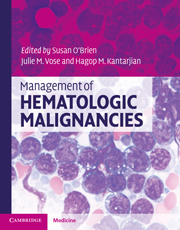Book contents
- Frontmatter
- Contents
- List of contributors
- 1 Molecular pathology of leukemia
- 2 Management of acute myeloid leukemia
- 3 Treatment of acute lymphoblastic leukemia (ALL) in adults
- 4 Chronic myeloid leukemia
- 5 Chronic lymphocytic leukemia/small lymphocytic lymphoma
- 6 Myelodysplastic syndromes (MDS)
- 7 Hairy cell leukemia
- 8 Acute promyelocytic leukemia: pathophysiology and clinical results update
- 9 Myeloproliferative neoplasms
- 10 Monoclonal gammopathy of undetermined significance, smoldering multiple myeloma, and multiple myeloma
- 11 Amyloidosis and other rare plasma cell dyscrasias
- 12 Waldenstrom's macroglobulinemia/lymphoplasmacytic lymphoma
- 13 WHO classification of lymphomas
- 14 Molecular pathology of lymphoma
- 15 International staging and response criteria for lymphomas
- 16 Treatment approach to diffuse large B-cell lymphomas
- 17 Mantle cell lymphoma
- 18 Follicular lymphomas
- 19 Hodgkin lymphoma: epidemiology, diagnosis, and treatment
- 20 Treatment approaches to MALT/marginal zone lymphoma
- 21 Peripheral T-cell lymphomas
- 22 Mycosis fungoides and Sézary syndrome
- 23 Central nervous system lymphoma
- 24 HIV-related lymphomas
- 25 Lymphoblastic lymphoma
- 26 Burkitt lymphoma
- Index
- References
5 - Chronic lymphocytic leukemia/small lymphocytic lymphoma
Published online by Cambridge University Press: 10 January 2011
- Frontmatter
- Contents
- List of contributors
- 1 Molecular pathology of leukemia
- 2 Management of acute myeloid leukemia
- 3 Treatment of acute lymphoblastic leukemia (ALL) in adults
- 4 Chronic myeloid leukemia
- 5 Chronic lymphocytic leukemia/small lymphocytic lymphoma
- 6 Myelodysplastic syndromes (MDS)
- 7 Hairy cell leukemia
- 8 Acute promyelocytic leukemia: pathophysiology and clinical results update
- 9 Myeloproliferative neoplasms
- 10 Monoclonal gammopathy of undetermined significance, smoldering multiple myeloma, and multiple myeloma
- 11 Amyloidosis and other rare plasma cell dyscrasias
- 12 Waldenstrom's macroglobulinemia/lymphoplasmacytic lymphoma
- 13 WHO classification of lymphomas
- 14 Molecular pathology of lymphoma
- 15 International staging and response criteria for lymphomas
- 16 Treatment approach to diffuse large B-cell lymphomas
- 17 Mantle cell lymphoma
- 18 Follicular lymphomas
- 19 Hodgkin lymphoma: epidemiology, diagnosis, and treatment
- 20 Treatment approaches to MALT/marginal zone lymphoma
- 21 Peripheral T-cell lymphomas
- 22 Mycosis fungoides and Sézary syndrome
- 23 Central nervous system lymphoma
- 24 HIV-related lymphomas
- 25 Lymphoblastic lymphoma
- 26 Burkitt lymphoma
- Index
- References
Summary
Introduction
Chronic lymphocytic leukemia (CLL) is the most common form of leukemia in adults in the Western world, accounting for nearly 25% of all leukemias with an estimated annual age-adjusted incidence of 3 per 100,000 persons in the United States. The median age at diagnosis is approximately 70 years, with 81% of the patients diagnosed when aged ≥ 60 years. Under the World Health Organization (WHO) classification, CLL is a B-cell neoplasm and the entity T-cell CLL has been reclassified as T-cell prolymphocytic leukemia (PLL). Recent data from the Surveillance, Epidemiology, and End Results (SEER) cancer statistics indicate that 5-year survival of patients with CLL is 73%.
Significant changes in the understanding and management of CLL have occurred in the last two decades. With the advent of newer treatment modalities, such as purine analogs and monoclonal antibodies, substantial improvements have been made in achieving complete responses (CR), with a proportion achieving molecular remissions and durable responses. Despite the advances in the treatment of patients with CLL, the majority of patients will relapse after primary therapy.
Diagnosis
The current diagnosis of CLL is based on minor modifications of the criteria originally proposed by the National Cancer Institute (NCI) (Table 5.1). A bone marrow evaluation is no longer required for diagnosis but is useful to determine the extent and pattern of involvement and to clarify the etiology of cytopenias.
The morphology and immunophenotype are adequate for diagnosis and to distinguish CLL from other disorders (Table 5.2).
- Type
- Chapter
- Information
- Management of Hematologic Malignancies , pp. 81 - 102Publisher: Cambridge University PressPrint publication year: 2010
References
- 1
- Cited by



